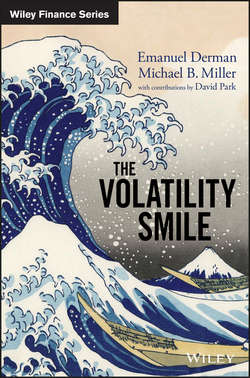Читать книгу The Volatility Smile - Park Curry David - Страница 9
На сайте Литреса книга снята с продажи.
Chapter 1
Overview
Introduction
ОглавлениеOur primary aim in this book is to provide the reader with an accessible, not-too-sophisticated introduction to models of the volatility smile. Prior to the 1987 global stock market crash, the Black-Scholes-Merton (BSM) option valuation model seemed to describe option markets reasonably well. After the crash, and ever since, equity index option markets have displayed a volatility smile, an anomaly in blatant disagreement with the BSM model. Since then, quants around the world have labored to extend the model to accommodate this anomaly. Our main focus in this book will be the theory of option valuation, the study of the BSM model and its limitations, and a detailed introduction to the extensions of the BSM model that attempt to rectify its problems. Most of the book is devoted to these topics.
A secondary motivation for writing this book originates in the great financial crisis of 2007–2008, which began with the collapse of the mortgage collateralized debt obligation (CDO) market, whose structured credit products were valued using financial engineering techniques. When the crisis began, some pundits blamed the practice of financial engineering for the mortgage market's meltdown. Paul Volcker, whose grandson was a financial engineer, wrote the following paragraph as part of an otherwise sensible speech he gave in 2009:
A year or so ago, my daughter had seen.. some disparaging remarks I had made about financial engineering. She sent it to my grandson, who normally didn't communicate with me very much. He sent me an email, “Grandpa, don't blame it on us! We were just following the orders we were getting from our bosses.” The only thing I could do was send him back an email, “I will not accept the Nuremberg excuse.”
Comparing financial modelers to Nazi war criminals seems extreme, and indeed, since then, opinions about modelers' responsibility for the financial meltdown have become more nuanced. Spain and Ireland developed housing market bubbles that, unlike those in the United States, were not inflated by complex financially engineered products. Paul Krugman has suggested that the root cause of the crisis lay in the West's rapid withdrawal of capital from Asia after the currency crisis of 1998, leading Asian countries thereafter to concentrate on exporting, saving, and hoarding, which led them to provide cheap credit that fueled speculation. Other competing explanations abound. As with all complex human events, it's impossible to pinpoint a single cause.
Nevertheless, models did play a part in the development of the crisis. In the face of very low safe yields, badly engineered financial models were indeed used to tempt investors – at times misleadingly and deceptively – into buying structured CDOs that promised optimistically high yields. Though our expertise lies in models for option valuation rather than mortgage securities, we also wanted to write a book that illustrates how to be sensible about model building.
